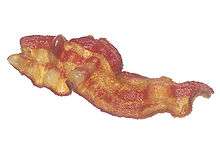Pīrādziņi
| Alternative names | pīrāgi, speķa rauši |
|---|---|
| Type | Pastry |
| Place of origin | Latvia |
| Main ingredients | Pastry, Onion and bacon. |
|
| |
A pīrāgs (plural - pīrāgi; diminutive - pīrādziņi) is an oblong or crescent-shaped baked Latvian bread roll or pastry, often containing a filling of finely chopped bacon cubes and onion. Pīrāgi range from 5 centimetres in length to 13 centimetres, depending on if they are intended as a snack or a more substantial meal. Smaller pīrāgi are often prized for their daintiness and are considered the work of a skilled cook.
As with many national dishes, Latvian families often have their own unique recipe for the dish, resulting in many variations of pīrāgi. Due to the amount of work involved to make pīrāgi, they are usually made only for special occasions and in very large numbers.
Variations
Other common pīrāgs fillings include fatty bacon, fatback (speķis), mixtures of ground or finely chopped meats (ground beef, ham and chicken with or without bacon), fish, cabbage and pressed cottage cheese. Pīrāgi come in two main varieties: plain bread pīrāgi and broth or soup pīrāgi (zupas or buljona pīrāgi). Bread pīrāgi come with a larger variety of fillings and are made using a yeast dough. Broth pīrāgi are made from a flaky pastry butter dough, often a sour cream dough, and are usually filled with boiled beef or sometimes cooked fish. These are intended to be eaten with a cup or bowl of good broth.
Preparation
The day before baking pīrāgi, the cook usually spends one or two hours preparing any meat and onion that will be used. Bacon and other fatty meats (such as bacon or back bacon) do not chop well in a food processor and tend to get caught on the blade, so the cook must hand chop these into tiny cubes, about 1.5 millimetres (about 1/16 inches). This is sometimes made easier by freezing the meat for a few minutes. Other less fatty meats (such as beef) tend to turn into a paste in the food processor, so if the meat is not already ground, the cook grinds it using a hand or electric grinder.
The day of baking, the cook makes the dough. This is a fairly standard white bread dough, with a varying amount of fat in it, depending on the particular family's recipe. Allowing the dough to proof and rise takes several hours, during which time the meat from the previous day is sauteed over a very low flame for a few minutes to ensure that the flavours in the filling meld a bit. When the dough has finished rising for bread pīrāgi, or the dough has chilled for bullion pīrāgi, the cook usually uses one of two methods to make the individual pīrāgi:
- The cook takes a few cups of dough and rolls out the whole lump using a rolling pin, or just the edge of the lump using a glass. The cook takes a tablespoon of filling and places it on the dough about 3 centimetres (about 1.5 inches) from one of the edges. The cook folds the edge of the dough over the filling, puts a glass over the dough and filling pile and cuts through both layers of dough on one side with the glass so that a half-moon-shaped pastry is created. The pressure from the glass cutting through the dough pinches the two dough layers together on the one open side. The pastry is re-shaped slightly to form an oblong or crescent shape.
- The cook takes a walnut-sized lump of dough and flattens it with a rolling pin or with fingers into a round dough disk. The cook then places a tablespoon of filling into the middle of the dough disk and folds two sides together to make a half-moon shape, pinching the two sides together. The resulting edges are then folded under and re-shaped to make a more oblong or crescent shape.
Prepared pastries are put into rows on pans, left to rise slightly, brushed with egg and then baked for a few minutes.
History and folklore
Pīrāgi were not a seasonal dish in Latvian society, because most ingredients needed to make the different varieties were available from the pantry year round. After potatoes had infiltrated Latvian society from the New World, sometime potatoes were also used to replace flour in the dough, allowing the pastries to be baked even when flour was unavailable. This means that pīrāgi could be baked any time and are historically associated with Latvian celebrations year round.
The two biggest historic Latvian celebrations are for summer solstice and winter solstice: Jāņi (June 24 - St. John's Day) and Ziemassvētki (Christmas). One of the most popular and familiar Latvian Ziemassvētki folk songs mentions pīrāgi:
Ziemassvētki sabraukuši
Rakstītām kamanām
Pīrāgam nabagam
Abi gali apdeguši
Christmas arrived
In a decorated sleigh
Oh that poor pīrāgs
Both ends were burnt
See also
References
- Grīns, Marğers and Māra Grīna. (1983). The Ancient Latvian Time-reckoning System, Festivals, and Celebrations. Lincoln: Latvian Institute, Division of American Latvian Association in the United States.
- Ladies Auxiliary of the Latvian Relief Society of Canada, Inc. (1991). Latvian Cooking. Hamilton: Ladies Auxiliary of the Latvian Relief Society of Canada, Inc.
- Zeberiņš, Dzidra. (1955). Ğimenes pavards. USA: Grāmatu draugs.
External links
- Piragi recipe http://www.sbs.com.au/food/recipe/904/Strautins_piragi
- Latvian Cooking, recipes for pork aspic and pīrāgi (speķa rauši)
- Piragi Facebook Page: https://www.facebook.com/piragi
